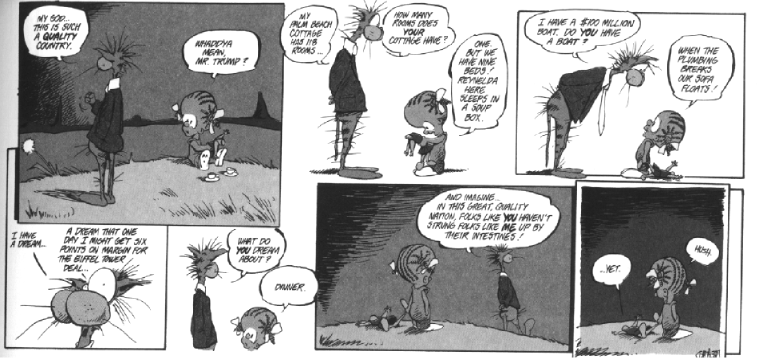
Bloom County © 1990 Berke Breathed. Used without permission. Click the image to get a readable version.

The Canterbury Tales, by Geoffrey Chaucer paints what is perhaps the
most accurate picture of medieval English society. In his preface
Chaucer divulges information about twenty-four social classes.
He uses satire to mock these characters. For the most part this
satire is of a humorous nature; occasionally it is vicious. It
is through this satire that he manages to criticize his society
and, in so doing, makes his work one of the first political cartoon.
A political cartoon is a work that comments on current issues or on a society in general. Often, a political cartoon has a strong underlying moral message. Political cartoons customarily have exaggerated characters and situations. Some use labels across every image to get at the point. Others are subtler with their imagery.
Obviously The Canterbury Tales is not illustrated as a cartoon is. It is composed of text. But a quantum leap in logic is not required in picking out the imagery that Chaucer used throughout the work:
Though so illustrious, he was
very wise
And bore himself as meekly as a maid.
He never yet had any vileness said
IN all his liufe, to whatsoever wight.
He was a truly perfect, gentle knight.
His steeds were good, but yet
he was not gay.
Of simple fustian wore a jupon
Sadly discolred by his habergeon
(ll. 67-71, 73-75)
One gets a clear mental image of the knight: bold and strong, yet mild and timid. He rode proud yet had tattered clothes. Chaucer may not have drawn with lines and shades; he drew with words.
The tales are filled with political commentary. During the fifteenth century, politics were inexorably linked to the Christian Church. Medieval life revolved around the clergy. It is no surprise then that politics and religion were so tightly wound. Although the Church was supposed to be the focus of morality, such was not the case. The Church was corrupt, and Chaucer aptly points this out in his preface through the characters of the Church he satirizes.
The Pardoner, described here, is one such corrupt person. His job is to pardon people for their sins. He manages to make a little extra profit from his job by blackmailing confessors or by selling them items that he says will lead to absolution but are, in fact, useless. All of the ecclesiastical characters are shown to be fraudulent, with the exception of one. The exception is an ideal character, the Parson. An ideal character is one that does not have a bad side to him. Of the three ideal characters in the poem, only one is ecclesiastical. The other two, the Plowman and the Knight, are not. These two are from the feudal order. This was the order that the peasant belonged to. Although feudalism was close to its end at the time of the poem's composition, Chaucer draws these characters in a far better light than ones working for the Church.
Many of these characters were hard-working and lived simply. Another example of political commentary in the poem is in the Oxford Student's part of the preface.
This student is poor, undoubtedly from his expensive education. The situation has spanned the gap of half a millennium and still plagues us today.
The poem manages to point out other moral issues. Most of the characters' tales are based upon some sort of maxim. For example, in the Pardoner's Tale a story is told about three men who are driven to death by greed.
Chaucer uses each character's story to add a little more insight to his poem.
Through these characters, through this satire, through these morals, Chaucer manages to point out the ills of society. The Canterbury Tales was just as poignant five hundred years ago as Bloom County or Mallard Fillmore is today. The political cartoon exists to expose the ills of society, and The Canterbury Tales. did a wonderful job of that Opus and Milo, Mallard Fillmore and every character in a political cartoon owe, at least in part, some of their existence to Geoffrey Chaucer and his poem.